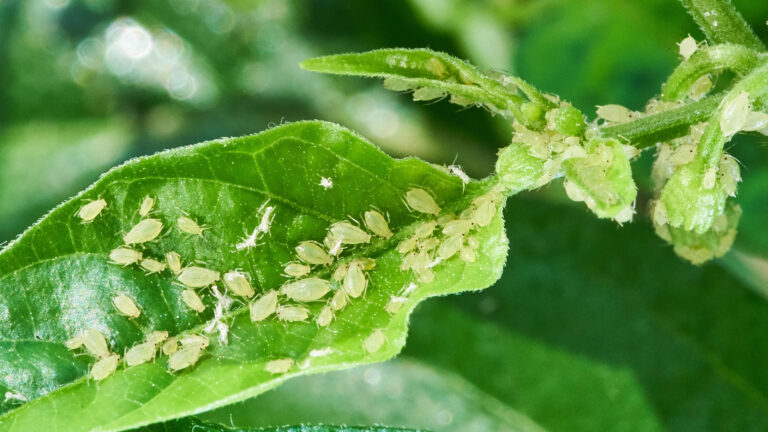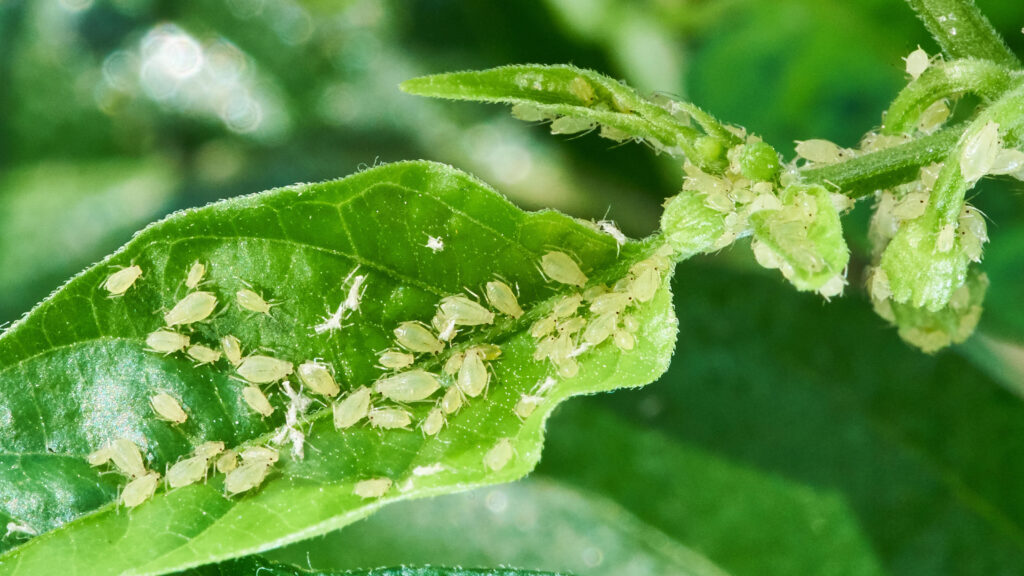Table of Contents
What Are Aphids?
Aphids (Aphidoidea) are small insects that feed on the sap of plants, often congregating in large colonies on the undersides of leaves. They can cause damage to plants by draining their nutrients and transmitting diseases.
10 Types of Aphids
Aphids encompass a vast array of species, each with its own unique characteristics and preferences. While it’s challenging to list every single type of aphid due to their sheer diversity, here are some common types grouped by their host plants or other distinctive features:
Green Peach Aphid (Myzus persicae): A widespread aphid species that feeds on a variety of plants, including peaches, peppers, potatoes, and tomatoes.
Cabbage Aphid (Brevicoryne brassicae): Often found on cabbage family plants such as cabbage, broccoli, and cauliflower.
Rose Aphid (Macrosiphum rosae): As the name suggests, this species is commonly found on roses, but it can also infest other flowering plants.
Cotton Aphid (Aphis gossypii): A significant pest of cotton plants, but it also attacks other crops such as melons, cucumbers, and citrus.
Melon Aphid (Aphis gossypii): Known for infesting melons, cucumbers, squash, and other cucurbit crops.
Potato Aphid (Macrosiphum euphorbiae): Feeds on potato plants as well as other members of the nightshade family, including tomatoes and eggplants.
Bean Aphid (Aphis fabae): Commonly infests beans, peas, and other leguminous crops.
Woolly Aphid (Eriosoma lanigerum): Recognizable by the white, waxy filaments covering their bodies. They can infest apple trees and other woody plants.
Winged Aphids (Alatae): These are not a specific species but rather winged forms of various aphid species. They develop wings to migrate to new plants or locations.
Aphids on Herbaceous Plants: This category includes numerous aphid species that infest herbs, flowers, and other non-woody plants. Examples include chrysanthemum aphids, dahlia aphids, and tulip bulb aphids.
Remember, this is just a small sampling of the vast diversity of aphid species. Each species may have specific adaptations, host plant preferences, and life cycles, making them a fascinating group to study in the context of agricultural and ecological systems.
How to Get Rid of Aphids
Getting rid of aphids can be challenging, but there are several methods you can try to control their population and minimize damage to your plants:
Pruning: Remove heavily infested parts of the plant, especially if the infestation is localized. Dispose of the affected plant material properly to prevent the spread of aphids.
Water Spray: Use a strong stream of water from a garden hose to dislodge aphids from the plants. Focus on the undersides of leaves where aphids often congregate. Repeat this process regularly to keep the aphid population under control.
Insecticidal Soap: Spray affected plants with insecticidal soap, which can suffocate aphids on contact. Be sure to follow the manufacturer’s instructions carefully and test the solution on a small area of the plant before widespread application.
Neem Oil: Neem oil is a natural insecticide derived from the neem tree. It can disrupt the growth and development of aphids and other pests. Mix neem oil with water according to the instructions and spray it on affected plants.
Beneficial Insects: Introduce natural predators of aphids, such as ladybugs, lacewings, and parasitic wasps, into your garden. These insects feed on aphids and can help keep their population in check.
Reflective Mulch: Reflective mulches, such as aluminum foil or reflective plastic, can deter aphids by confusing them with bright light and reflections. Place mulch around the base of affected plants to repel aphids.
Companion Planting: Planting certain herbs and flowers, such as chives, garlic, marigolds, and nasturtiums, alongside susceptible plants can help repel aphids. These companion plants emit odors or compounds that deter aphids and other pests.
Organic Sprays: Homemade organic sprays using ingredients like garlic, hot pepper, or onion can act as repellents for aphids. Blend these ingredients with water and strain before spraying on plants. Test on a small area first to avoid damaging plants.
Row Covers: Use row covers made of fine mesh or fabric to physically exclude aphids from accessing susceptible plants. This method works best for smaller plants or during the early stages of plant growth.
Regular Monitoring: Inspect your plants regularly for signs of aphid infestation, such as curled leaves, yellowing, or sticky honeydew residue. Early detection allows for prompt intervention and prevents aphid populations from spiraling out of control.
Remember to combine different methods for the most effective aphid control, and be patient as it may take time to see results. Additionally, practicing good garden hygiene, such as removing weeds and maintaining plant health, can help prevent future aphid infestations.

7 Harmful Effects of Aphids on Plants
Aphids, those tiny, sap-sucking insects, can wreak havoc on plants in various ways, causing a range of harmful effects:
Stunted Growth: Aphids feed on the sap of plants, depriving them of essential nutrients. This can lead to stunted growth and overall poor plant development.
Deformation: As aphids feed, they inject saliva into the plant, which can cause deformities in leaves, stems, and flowers. This deformation not only affects the aesthetic appeal of the plant but can also impair its ability to function properly.
Yellowing Leaves: Aphids can cause leaves to yellow and wilt by sucking out the plant’s juices and disrupting its ability to photosynthesize effectively. This can weaken the plant and make it more susceptible to other stresses, such as drought or disease.
Transmission of Diseases: Aphids are vectors for various plant diseases, such as viruses and phytoplasmas. When they feed on an infected plant, they can pick up the pathogens and transmit them to healthy plants as they move from one plant to another. This can lead to the spread of diseases throughout an entire garden or crop field.
Honeydew and Sooty Mold: Aphids excrete a sticky substance called honeydew as they feed on plants. This honeydew can attract other pests like ants and wasps and can also serve as a medium for the growth of sooty mold, which can further inhibit photosynthesis and weaken the plant.
Reduced Yield: Severe aphid infestations can significantly reduce the yield of crops by affecting their growth and development. This can have economic consequences for farmers and gardeners who rely on these plants for food or income.
Weakened Resistance: Prolonged aphid infestations can weaken a plant’s natural defenses, making it more vulnerable to other pests and diseases. This can create a cycle of damage where the plant becomes increasingly susceptible to further attacks.
Overall, while aphids may seem small and insignificant individually, their cumulative effect on plants can be substantial, leading to decreased plant health, reduced crop yields, and increased susceptibility to other stressors. Controlling aphid populations through various methods, such as biological controls, insecticidal soaps, or natural predators, is essential for maintaining healthy plants and productive gardens or farms.
FAQs
What are aphids? Aphids are small, soft-bodied insects that commonly infest plants. They can be green, black, brown, yellow, or pink in color and are often found in large groups on the undersides of leaves or along the stems of plants.
What damage do aphids cause to plants? Aphids feed on the sap of plants by piercing the plant tissue with their needle-like mouthparts. This can cause stunted growth, distorted leaves, yellowing, wilting, and even plant death in severe infestations. Aphids also excrete honeydew, a sticky substance that can attract other pests like ants and promote the growth of sooty mold.
How do I identify aphids on my plants? Aphids are usually visible to the naked eye and can be identified by their small size, soft bodies, and pear-shaped appearance. They often congregate in clusters on the undersides of leaves or on new growth. Some species may have wings, while others are wingless.
How can I prevent aphids from infesting my plants? To prevent aphids, maintain plant health through proper watering, fertilization, and soil management practices. Avoid over-fertilizing with nitrogen, as this can promote aphid infestations. Additionally, encourage natural predators of aphids, such as ladybugs and lacewings, by planting diverse gardens.
What are some organic methods to control aphids? Organic methods to control aphids include spraying plants with insecticidal soap or neem oil, introducing beneficial insects like ladybugs or lacewings, using reflective mulch to deter aphids, and practicing companion planting with plants that repel aphids.
Are there any chemical insecticides effective against aphids? Yes, there are chemical insecticides available for controlling aphids, but they should be used with caution and according to the label instructions. Some common insecticides used against aphids include pyrethroids, neonicotinoids, and organophosphates.
Can aphids transmit diseases to plants? Yes, aphids can transmit viral diseases to plants through their feeding activities. Some common plant viruses spread by aphids include cucumber mosaic virus, potato virus Y, and bean common mosaic virus. Infected plants may exhibit symptoms such as mottled leaves, stunted growth, and reduced yield.
How do I get rid of aphids naturally? Natural methods to get rid of aphids include spraying plants with a strong jet of water, using insecticidal soap or neem oil, introducing beneficial insects like ladybugs or lacewings, practicing companion planting, and maintaining plant health through cultural practices.
Share this post:




